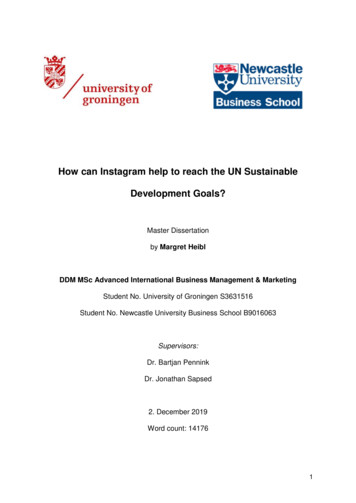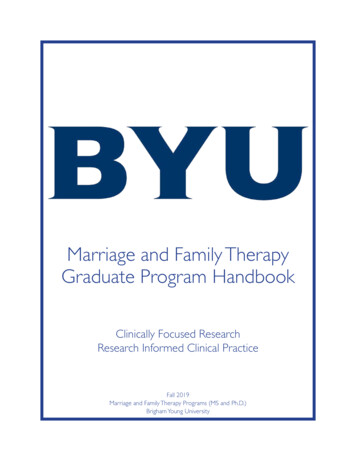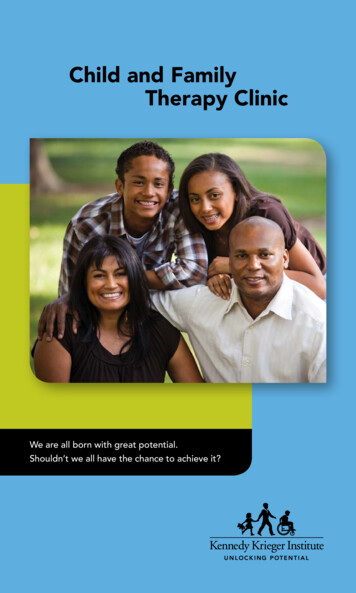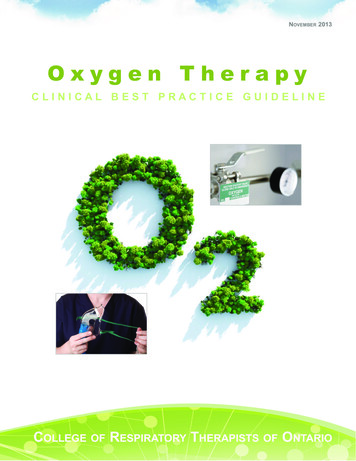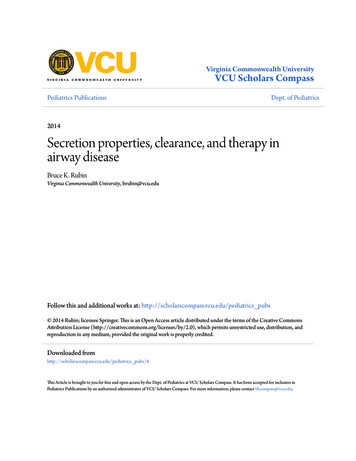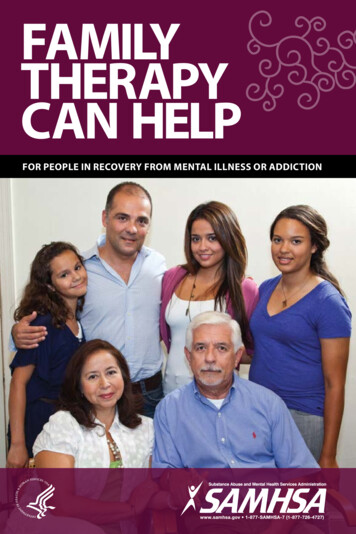
Transcription
FAMILYTHERAPYCAN HELPFOR PEOPLE IN RECOVERY FROM MENTAL ILLNESS OR ADDICTIONU.S. DEPARTMENT OF HEALTH AND HUMAN SERVICESSubstance Abuse and Mental Health Services AdministrationCenter for Substance Abuse Treatmentwww.samhsa.gov
FAMILY THERAPY CAN HELPFOR PEOPLE IN RECOVERY FROM MENTAL ILLNESS OR ADDICTIONContentsIntroduction1What is family therapy?2Who can attend family therapy?4When should family therapy start?5What are the goals of family therapy?6Is family therapy the same as family education?8Who conducts family therapy sessions?10How is family therapy organized?12What happens in a particular session?14What if family members are unwilling to take part?16Is family therapy effective?18This booklet was developed as a collateral product to Treatment Improvement Protocol (TIP) 39,Substance Abuse Treatment and Family Therapy. It was prepared for the Substance Abuse and MentalHealth Services Administration (SAMHSA) by the Knowledge Application Program, a Joint Venture ofThe CDM Group, Inc., and JBS International, Inc., under contract number 270-09-0307, with SAMHSA,U.S. Department of Health and Human Services (HHS). Christina Currier served as the ContractingOfficer’s Representative.All materials appearing in this publication except those taken from copyrighted sources are in thepublic domain and may be reproduced or copied without permission from SAMHSA. However,this publication may not be reproduced or distributed for a fee without the specific, writtenauthorization of the Office of Communications, SAMHSA, HHS.The views, opinions, and content of this publication are those of the authors and do not necessarilyreflect the views, opinions, or policies of SAMHSA or HHS.
INTRODUCTIONWhen someone is affected by mentalillness or addiction, it can affect theentire family. When that person enterstreatment, the family’s pain andconfusion don’t just go away. Howdoes any family member move pastthe damage that has occurred? Howdoes the family as a whole strengthenthe ties that hold it together?Family therapy is one answer. It workstogether with individual therapy forthe benefit of all family members.1
“I wonder if I can stayin recovery when I’mso cut off from thepeople I love.”WHAT IS FAMILYTHERAPY?Family therapy is based on the idea thata family is a system of different parts. Achange in any part of the system willtrigger changes in all the other parts.This means that when one memberof a family is affected by a behavioralhealth disorder such as mental illness oraddiction, everyone is affected.As a result, family dynamics canchange in unhealthy ways. Lies andsecrets can build up in the family.Some family members may take ontoo much responsibility, other familymembers may act out, and some mayjust shut down.Sometimes conditions at home arealready unhappy before a familymember’s mental illness or addictionemerges. That person’s changingbehaviors can throw the family intoeven greater turmoil.2Often a family remains stuck inunhealthy patterns even after thefamily member with the behavioralhealth disorder moves into recovery.Even in the best circumstances,families can find it hard to adjustto the person in their midst whois recovering, who is behavingdifferently than before, and whoneeds support.Family therapy can help the familyas a whole recover and heal. It canhelp all members of the family makespecific, positive changes as theperson in recovery changes. Thesechanges can help all family membersheal from the trauma of mentalillness or addiction.
“It feels good to beconnected again.”3
WHO CAN ATTENDFAMILY THERAPY?“Family” means a group of twoor more people with close andenduring emotional ties. Using thisdefinition, each person in treatmentfor a behavioral health disorder hasa unique set of family members.Therapists don’t decide who shouldbe in family therapy. Instead they ask,“Who is most important to you?” parents godparents spouses or partners godchildren in-laws blended family members siblings extended family members children friends elected, chosen, or honoraryfamily members fellow veterans other relatives stepparents stepchildren foster parents foster children4Sometimes members of a familylive together, but sometimes theylive apart. Either way, if they areconsidered family by the person intreatment, they can be included infamily therapy. colleagues who care mentors mutual-help group members sponsors
WHEN SHOULD FAMILYTHERAPY START?Family therapy is typically introducedafter the individual in treatment formental illness or addiction has madeprogress in recovery. This could be afew months after treatment starts, ora year or more later.Timing is important because peoplenew to recovery have a lot to do. Theyare working to remain stable in theirnew patterns of behavior and ways ofthinking. They are just beginning to facethe many changes they must make tostay mentally healthy or to remain sober.They are learning such things as how todeal with urges to fall into old patterns,how to resist triggers and cravings, howto adhere to medication regimens, andhow to avoid temptations to rationalizeand make excuses. For them to explorefamily issues at the same time can be toomuch. It can potentially contribute torelapse into mental illness or substanceusing behaviors.Family therapy tends to be mosthelpful once the person in treatmentis fully committed to the recoveryprocess and is ready to make morechanges. The person’s counselorcan advise on the best time to startfamily therapy.Stages of RecoveryIndividual in RecoveryFrom AddictionIndividual in RecoveryFrom Mental IllnessFamilyAttainmentof sobrietyWorking with individualtherapist to identifytreatment goalsThe family system isunbalanced, but healthychange is possibleAdjustmentto sobrietyWorking through variousaspects of the treatmentplan (e.g., actively engagingin therapy sessions, takingmedications as prescribed,doing therapy “homework”)The family works ondeveloping a new systemLong-termmaintenanceof sobrietyTermination of treatment aftergoals have been achieved anda maintenance plan has beenestablishedThe family stabilizesa new and healthierlifestyle5
“There is so much hurtand anger.”WHAT ARE THEGOALS OF FAMILYTHERAPY?There are two main goals in familytherapy. One goal is to help everyonegive the right kind of support to thefamily member in behavioral healthtreatment, so that recovery sticks andrelapse is avoided. The other goal is tostrengthen the whole family’s emotionalhealth, so that everyone can thrive.Specific objectives for family therapyare unique to each family, and theseobjectives may change over time. Thefamily decides for itself what to focuson, and when.FAMILY THERAPY OBJECTIVES6Distrust ReconciliationGuilt ForgivenessStress StrengthFrustration UnderstandingDespair HopeSadness SupportAnger PeaceConflict AgreementCrisis Resolution
“We’ve let go of so manynegative emotions.”7
“I wish I knew how to makemy daughter quit drinking.”IS FAMILY THERAPYTHE SAME AS FAMILYEDUCATION?No, family therapy is more thanfamily education. Many behavioralhealth programs conduct educationsessions for families on such topics asa particular mental illness, drug andalcohol addiction, treatment, relapse,and recovery. Families can use thisinformation to better understand whatis happening, how it might affect them,and what to do to help the familymember in treatment.Education is important, but manyfamilies also need help applying theinformation they have learned. Familytherapy provides a safe and neutral spacein which everyone learns how to adjustto life with a member recovering frommental illness or addiction. The therapisthelps the family make changes so thatmembers support each other and treateach other with respect, stop enablingunhealthy behaviors, and learn to trusteach other.8Working with a specially trained therapist,family members take a close look at howthey act with one another. They look atwhether they are conducting themselvesin ways that are hurtful or helpful. Familymembers learn how to modify theirbehaviors so that they support the needsof the person in recovery as well as theneeds of the whole family, includingthemselves. They also learn how to bettercommunicate with each other, and theypractice new ways of talking, relating,and behaving.Sometimes, a family has problems thathave been hidden behind the drama ofmental illness or addiction. These problemsrise to the surface once the person witha behavioral health disorder goes intotreatment. The family therapist can help thefamily talk together to resolve concerns andmend relationships. The family therapist canrefer members of the family to individualcounseling if they need or request it.
“I’ve learned how to focus onmy own actions and responses.”9
“I’m worried about howmy wife’s mental illnessis affecting our daughter.”WHO CONDUCTSFAMILY THERAPYSESSIONS?The leader of a family therapysession may be a licensed familytherapist, social worker, psychiatrist,psychologist, counselor, clergymember, or some other type ofprofessional. Whatever the title, theleader must meet the legal andprofessional requirements for workingin family therapy. Special training andskills are required, because familytherapy is quite different from oneon-one counseling.The professional who conducts familytherapy sessions may be associatedwith a center that specializes in thiswork. Sometimes the professional ison the staff of the behavioral healthtreatment program where the familymember is a client.10It’s important that the professionalwho conducts the sessions besensitive to the family’s uniquecharacteristics. This person does nothave to have the same backgroundas the family in terms of culture,race, ethnic group, or any otherfactor. However, he or she mustbe respectful and understandingwithout being judgmental.Typically, the family is provided witha 24-hour crisis phone number.If there is a family emergencybetween sessions, counselingprofessionals who staff the crisis linecan provide support.
“She’s getting the help she needsto handle our family situation.”11
“I don’t even know howto be with my parents.”HOW IS FAMILY THERAPYORGANIZED?Family therapy involves the entire familymeeting together. Sometimes part ofthe family meets. The family therapistmay work one-on-one with a particularfamily member, in addition to the familysessions, although this is not typical.Sessions usually last about an hour andtake place at a clinic, at the therapist’soffice, or—less often—in a familymember’s home. The focus of the sessionmay be on the person in treatment, onanother family member, or on the familyas a whole. Sessions can be low-key orintense, depending on the purpose ofthe particular session.Before starting the first session, thetherapist may ask family members tosign a contract. This is a way to showthat family members agree to certainbehaviors, such as to continue individualtreatment or to not interrupt each other.Family members also may be asked tosign a consent form to show that theyunderstand the ground rules for privacyand confidentiality. Usually, everyone12including the therapist is expectedto respect the privacy of what is saidduring each session and not share it withanyone outside the group. There aresome exceptions to this rule, which willbe explained on the consent form andby the therapist.In the session, the family therapist mayask questions or listen and observe whilethe others talk. The therapist does this tolearn such things as how family membersbehave and communicate with eachother and what the family’s strengths andneeds are. The particular techniques usedby the therapist will depend on the phaseof treatment for the member in treatmentand the family’s readiness for change.The family therapist may refer thewhole family or individual membersto extra sources of help. For example,the therapist may encourage familymembers to go for individual counseling,to join a mutual-help group, or to takeclasses on topics such as parenting oranger management.
“It feels more natural now.”13
“I need to fix the damage I didto my family while on drugs.”WHAT HAPPENS IN APARTICULAR SESSION?There are many things that canhappen in family therapy. A sessioncan be devoted to talking about familyconcerns and how people are feeling.Family members might use the sessionto talk about a particular crisis orproblem that needs solving. Or, theymight want to focus on the changesthat have been happening.Another possible topic for a familytherapy session is coping skills, suchas how to deal with anger, regret,or sadness. Sometimes just lettingout feelings and talking about themin therapy sessions can bring relief,understanding, and healing.The focus of a session might be onlearning how to communicate moreeffectively with each other. For example,the therapist might coach a family14member to speak up, to practice saying“no” to unreasonable demands, or togive a compliment. Family membersmight be asked to rephrase a statementin a more positive way. The therapistalso might help family membersimprove their listening and observingskills to reduce misunderstanding.Sometimes the therapist asks familymembers to do homework beforethe next session. For example, thetherapist might ask family membersto watch for nice things that otherfamily members say during theweek. The therapist might ask familymembers to eat a meal together orto do something fun together, likeplay board games or go bowling. Thehomework is designed to help familymembers practice new and healthierways of behaving with each other.
“I’m learning how to make amends.”15
“He’s the problem—not me.”WHAT IF FAMILYMEMBERS AREUNWILLING TOTAKE PART?Sometimes family members areunwilling to join family therapy. Thereare many possible reasons for this:Fear. They may prefer to have thefamily unit stay as it is, even if that ispainful, rather than take chances withthe unknown.Fatigue. They may be tired of dealingwith the issues.Concerns about power. They may feelthat they have an advantage the waythings are—or that they don’t, butfamily therapy won’t fix it.Distrust. They may be unwilling torisk speaking frankly with other familymembers or in front of a therapist.16Skepticism. They may not beconvinced that family therapy will beuseful, or they may have tried it beforeand not liked it.It may help to have the family therapisttalk one-on-one with unwilling familymembers. Together they can identifythe reasons for resistance, figure outhow to resolve concerns, and discussthe benefits of family therapy.Sometimes what’s needed is simplytime. Willing members of the familycan choose to get started. Unwillingmembers can join when they areready.
“We’re both changing,and it’s good.”17
“My partner and I need to learnhow to live together drug-free.”IS FAMILY THERAPYEFFECTIVE?Research suggests that behavioralhealth treatment that includesfamily therapy works better thantreatment that does not. For peoplewith mental illness, family therapy inconjunction with individual treatmentcan increase medication adherence,reduce rates of relapse andrehospitalization, reduce psychiatricsymptoms, and relieve stress.For people with addiction, familytherapy can help them decide to enteror stay in treatment. It can reduce theirrisk of dropping out of treatment. Italso can reduce their continued use ofalcohol or drugs, discourage relapse,and promote long-term recovery.Family therapy benefits otherfamily members besides the person18in treatment. By making positivechanges in family dynamics, thetherapy can reduce the burden ofstress that other family membersfeel. It can prevent additionalfamily members from moving intodrug or alcohol use. Research alsoshows that family therapy canimprove how couples treat eachother, how children behave, howthe whole family gets along, andhow the family connects with itsneighbors.Family therapy isn’t alwayseasy. There will be strugglesfor everyone involved, but theoutcome is worth it. Family therapyis an effective way to help theperson in treatment, while alsohelping the family as a whole.
“We’re more solid now thatwe communicate better.”19
SAMHSA HOTLINESFind Substance Abuse and Mental Health Serviceshttp://www.samhsa.gov/treatment24/7 Treatment Referral Line1-800-662-4357 (HELP)National Suicide Prevention Lifeline1-800-273-TALK CTORY OF THERAPISTSAmerican Association for Marriage and Family TherapyProvides consumer information and a Therapist Locator Directory.http://www.aamft.orgMUTUAL-HELP PROGRAMSThe support groups offered by the following organizations are not run by professional family therapists.However, they are free and they can be helpful to people with addictions and their family members.Adult Children of Alcoholicshttp://www.adultchildren.orgAl-Anon Family Groupshttp://www.al-anon.orgAlcoholics Anonymoushttp://www.aa.orgCo-Anon Family Groupshttp://www.co-anon.orgCo-Dependents Anonymoushttp://www.coda.orgFamilies Anonymoushttp://www.familiesanonymous.orgNar-Anon Family Groupshttp://www.nar-anon.orgNarcotics Anonymoushttp://www.na.org20
Two ways to obtain FREE consumer publications fromSAMHSA’s Knowledge Application Program (KAP):1. Download or order from the SAMHSA Store athttp://store.samhsa.gov.2. Call 1-877-SAMHSA-7 (1-877-726-4727)(English and Español).Many KAP consumer publications are also available fordownload from the SAMHSA Store in additional languages:Cambodian (Khmer), Chinese, Korean, Russian, Spanish,and Vietnamese.
HHS Publication No. (SMA) 13-4784Printed 2013
after the individual in treatment for mental illness or addiction has made progress in recovery. This could be a few months after treatment starts, or a year or more later. Timing is important because people . new to recovery have a lot to do. They are working to remain stabl




